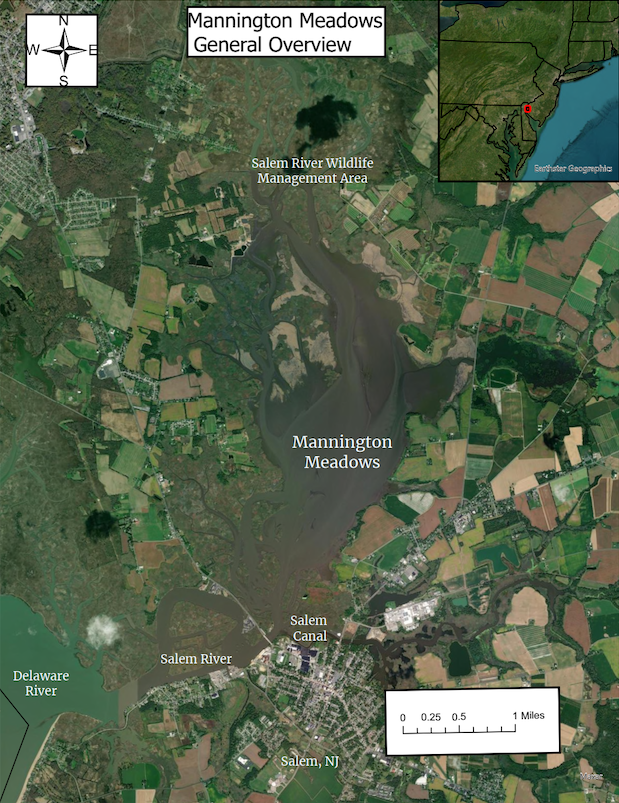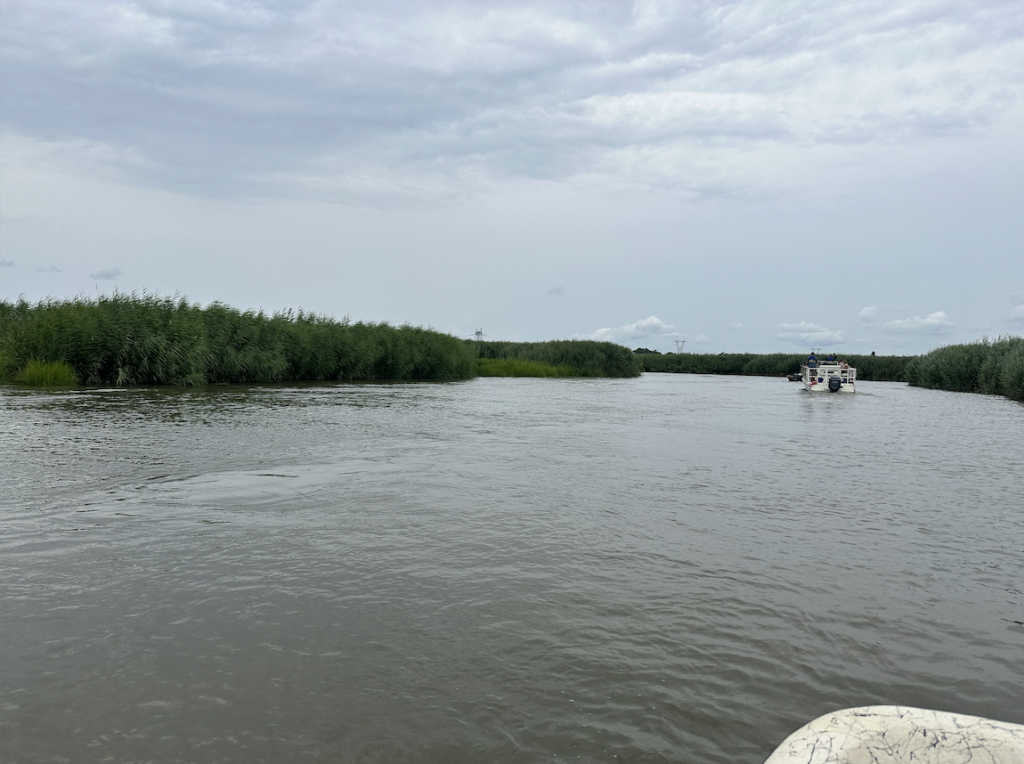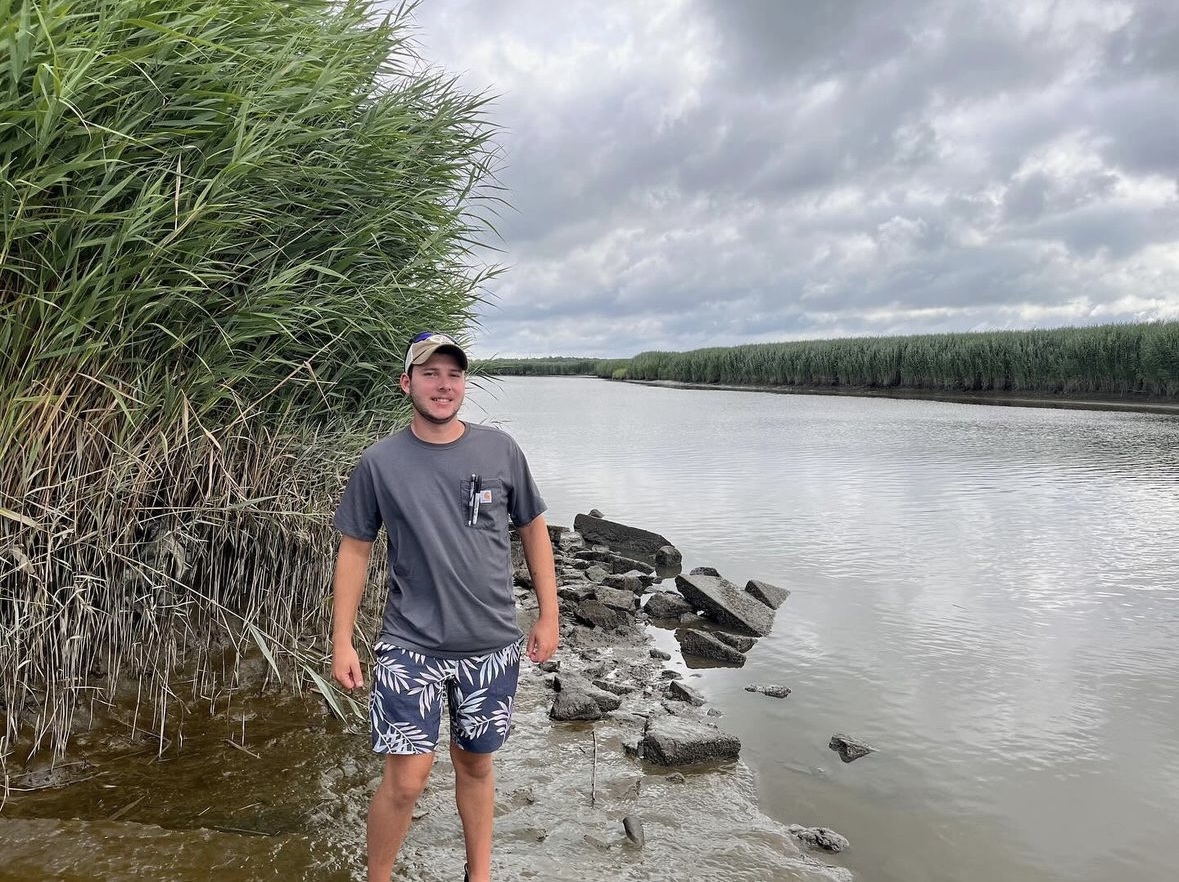Graduate student Nicholas Austin has spent the last two years compiling a full profile of a once-freshwater wetland in New Jersey. His work is not only a thesis topic for his own Master’s degree, it’s blazing a path for future students to continue working towards the protection of this site.
Austin’s graduate research journey began at an unlikely time–the day he was laid off from his job as a consulting scientist.
“I originally graduated from Roanoke College in 2022, [after which] I got a job at a small consulting firm,” Austin said. “Unfortunately, the company was going through some tough financial times–but it’s pretty funny. The day I got laid off, I called Dr. Rhett Jackson, I told him I was interested in grad school. A few days later, he called me back: ‘Hey, we’ve got this brand new assistantship program with Ducks Unlimited. Are you interested? Because we’d like to offer it to you.”
As Austin graduates with his Master’s degree in natural resources (under his advisor, Dr. Jackson), he marks the first Natural Infrastructure Fellow graduate from the Warnell School of Forestry and Natural Resources.
His thesis project? Save Mannington Meadows.
Mannington Meadows is located in Salem County, New Jersey, just down the river from Philadelphia. It’s located in one of the poorest counties in the state, with extremely rural stretches that are largely used for recreation. Prior to 1890, the marsh was approximately 6,000 acres, providing migratory habitat for bird species and water resources for the nearby community.
In the early 20th century, much of the marsh was ditched and drained of water for agricultural use. The construction of the Salem shipping canal in 1925 and the diversion of the Salem River to the Delaware River in 1935 to support the Chemours (previously DuPont) chemical plant have compounded this water loss, significantly reducing freshwater inputs to the marsh. Today Mannington Meadows is about half the size it originally was, now 3,000 acres.
This altered hydrologic profile of the wetland means the land is losing sediment as it gets trapped in shipping canals and behind dams. The proximity of the marsh to the Delaware estuary also means that this loss of sediment and rising sea levels expose the freshwater marsh to higher tides and threats of saltwater intrusion.

“Basically, it’s lost all its freshwater input,” Austin explained. “It’s been losing sediment and freshwater inflow since 1890.”
One factor that may be impacting the erosion of the marsh is ongoing dredging by the US Army Corps of Engineers. The Corps removes sediment from the bottoms of rivers and harbors to increase ease and safety for shipping, keeping waters deep enough for large vessels to pass through. For an eroding wetland, that sediment can be put to good use–but only if it’s placed well.
“They put [sediment] down and it washes away,” Austin explained. “They don’t really have a plan for putting it in areas where it will stay. It’s not ideal.”
The goal of Austin’s work has been to help fill that management gap, finding solutions that will satisfy needs for shipping and agriculture while still supporting the marsh. His thesis includes a study of the causes of erosion within the wetland, as well as a proposal for restoration methods that may help reduce the sediment loss. “[Our goal is to] bring it back to what Mannington Meadows originally was like as a freshwater marshland,” he said.
But part of the challenge of this work–and why it will take more than just one graduate student to “complete” the project–is a lack of data.
“There’s never been a species habitat assessment, there’s not really accurate Lidar data, and even just looking at old maps and aerial imagery, there’s a pretty big gap from 1950 to 1970 as well as prior to 1930,” Austin said. “There’s just a huge lack of data.”
His consulting background proved to be helpful in this project: “I was a staff scientist, so I did a lot of groundwater sampling, soil sampling, and looking at groundwater and soil contamination. I also did a lot of remediation oversight for contractors.” Austin’s research skills allowed him to begin bridging the gap, helping management partners at the Army Corps and conservation partners at Ducks Unlimited make restoration plans for the Meadows.
While Austin defended his thesis on June 18, 2025, and is heading into the next stage of his career, the effort to protect Mannington Meadows isn’t over. Incoming Master’s student Jesse Sanchez, also a NI Fellow, is picking up the torch.
“Jesse’s kind of doing the total opposite of what I’m doing,” Austin laughed. “I was collecting the historical background, looking at what the problem is. Jesse is coming in to do the modeling part.” The next phase of the project will start this fall as Sanchez works to model tidal flow velocities in the wetland, contributing to the data gap and looking at potential areas for strategic sediment placement.
“I’m hopeful that my research, getting this historical background, will make a big impact with not only my work, but also Jesse’s work to model the tidal flow,” he said. “Hopefully, 10 years from now, we’ve both helped Mannington Meadows become more of its natural state.”

Austin is getting ready to leave UGA, but he’s not heading back to New Jersey. “I’m hoping to do consulting work again as an environmental scientist, in the South or the Mid-Atlantic.” That’s despite not only his field site being in NJ, but also his hometown. Why not continue to work up North?
“There are more wetlands in the South,” he said. “Also, I really don’t want to give up the warm weather.”
Nicholas Austin is advised by Warnell professor Dr. Rhett Jackson. His work has also been completed with help from Jim Feaga from the Ducks Unlimited Philadelphia Office, as well as help from the US Army Corps of Engineers Philadelphia District Office. Austin’s Fellowship was supported by Ducks Unlimited, our partners in the Natural Infrastructure Graduate Fellowship. More information about this funded Master’s opportunity is available here.


